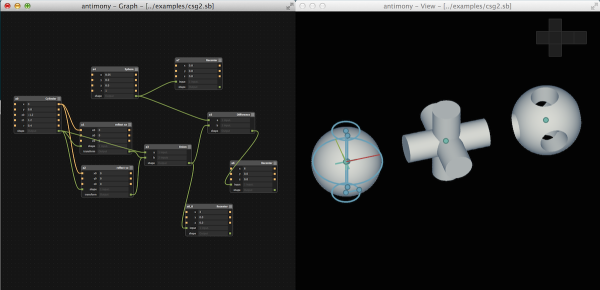The world of free 3D-modeling software tends to be grim when compared to the expensive professional packages. Furthermore, 3D CAD modeling software suggestions seem to throw an uproar when new users seek open-source or inexpensive alternatives. Taking a step apart from the rest, [Matt] has developed his own open-source CAD package with a spin that inverts the typical way we do CAD.
Antimony is a fresh perspective on 3D modeling. In contrast to Blender’s “free-form sculpting” and Solidworks’ sequential extrudes and cuts, Antimony invites you to break down your model into a network of both primitive geometry and operations that interact with that geometry.
Functionally, Antimony represents objects as a graphical collection of nodes that encode both primitives and operations. Want a cylinder? Start with a circle node and pipe it into an extrude node. Need to cut out some part geometry? Try defining it with one or more primitives, and then perform a boolean intersection operation. Users can even write their own nodes with custom scripts written in Python. Overall, Antimony boasts the power of parametric design similar to OpenSCAD while it also boosts readability with a graphical, rather than text-based, part description. Finally, because part geometry is essentially stored as a series of instructions, the process of modeling the part does not limit the resolution of the output .STL mesh. (Think: vector-based images, versus pixel-based images).
Current versions of the software are available for both Mac and Linux, and the entire project is open-source and available on the Githubs. (For the shrewd-eyed software developers, most of the project is written with Python that interacts with lower-level routines handled in C++ and exposed through Boost.Python.) Take a video tour of an Antimony workflow with [Matt] after the break. All-in-all, despite that the software is still in its alpha stages, it’s highly functional and (for the block-diagram fans) intuitive. We’re thrilled to put our programming hats on and try CAD from, as [Matt] coins it “a parallel universe.”
Continue reading “Otherworldy CAD Software Hails From A Parallel Universe”












